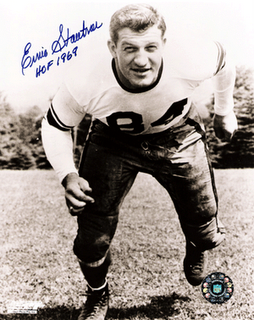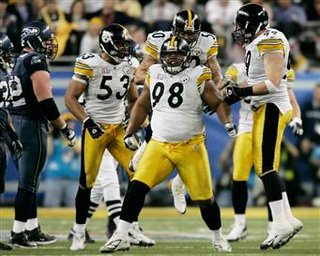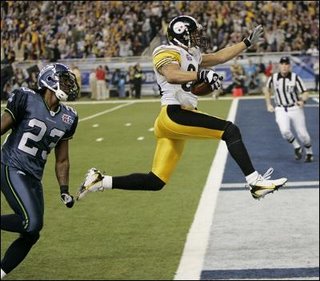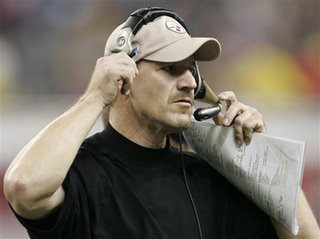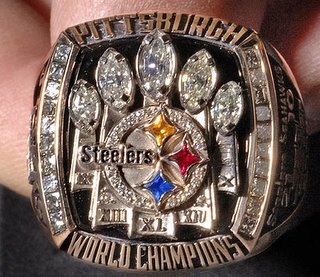 Joe Bendel
Joe BendelPITTSBURGH TRIBUNE-REVIEW
Sunday, February 12, 2006
Underneath a baking August sun, eager men in black helmets moved in unison at St. Vincent College in Latrobe. Beads of sweat trickled down their faces and across their necks as they attempted to defy the enervating heat.
"We're loving it," Steelers linebacker Larry Foote said, seemingly in a state of euphoria. "This is what it's all about. We're out here trying to win a championship."
Foote's words were powerful, but hardly unique. Most football players enter training camp with unbridled enthusiasm, with hopes of winning the game's ultimate prize: The Super Bowl.
Turns out, Foote got it right. The Steelers ended 26 years of franchise frustration last Sunday with a 21-10 victory over the Seattle Seahawks in Super Bowl XL in Detroit.
So, why was Foote so sure of himself?
"I just have a good feeling about these guys," he said then. "We have the right type of mix."
The Steelers had a clean slate on that sweltering day when Foote was doing his prognosticating -- no wins, no losses, no AFC Championship game letdown. The preseason magazines were delivering mixed reviews, with some listing them as legitimate contenders and others as pretenders.
In one publication, the author wrote: "While the Steelers will make a pass at being less predictable by opening the playbook, don't expect too much to change, including the team's postseason frustrations."
Another scribe put it this way: "The Steelers are favorites to repeat as AFC North champions. If (quarterback Ben) Roethlisberger takes a step forward in his development and if the defense remains a force, something could come of those AFC title aspirations."
In the midst of these "pretender/contender" debates, the Steelers were dealing with the holdout of Pro Bowl wide receiver Hines Ward and the less-than-stellar play of Roethlisberger.
Ward eventually returned to the team, 15 days after the start of camp, but some wondered if the chemistry would be affected by his extended absence.
Roethlisberger, who had two substandard games in the '04 playoffs after going 13-0 in the regular season as a rookie starter, looked like he might be in postseason form -- which was not good.
His passer rating in the preseason was 32.8 and some wondered if he could come close to duplicating his rookie season, during which the Steelers were 15-1 and reached the AFC final for the second time in four years.
Might these Steelers be in big trouble?
You never would have guessed it in observing the demeanor of the man in charge -- 14-year veteran coach Bill Cowher.
He was their rock.
"We feed off of him," Foote said. "He's our leader."
And while it's true that Cowher once said the passing game was becoming a "concern" late in the preseason, his typical response to questions about Roethlisberger was, "Ben will be fine."
He also refrained from saying a derisive word about Ward's holdout, even though his star wide receiver still had a year remaining on his contract. And he was not shaken when expected starting tailback Duce Staley required athroscopic knee surgery at training camp or when Pro Bowl linebacker Joey Porter required arthroscopic knee surgery for stomping his foot after beating a free-agent offensive lineman in a pass-blocking drill.
He was already without two starting offensive linemen and a former first-round wideout in Plaxico Burress from the previous season, but Cowher was the picture of stability, no matter how bad things might have looked from the outside.
His team kept sweating, kept plugging away.
Bearing downUnderneath a frigid December sky, self-assured men in black helmets walked with a purpose. Snow and rain fell in front of them and their home field looked like a mosh pit.
They were undaunted.
"This is our kind of weather, Pittsburgh Steelers weather," running back Jerome Bettis proclaimed.
Bettis and his teammates went out and played Pittsburgh Steelers football on this day. He ran for 101 yards, with 100 coming in the second half, and the Steelers ended the Chicago Bears' eight-game winning streak with a 21-9 victory.
More importantly, the Steelers set the tone for the rest of the season. They had been staring at a 7-5 record following three consecutive losses, but they stayed the course against the up-and-coming Bears.
"We had to win, so we went out and did it," safety Chris Hope said. "But it has to be about one game at a time from here on in."
It was.
The Steelers never lost again. They beat Minnesota, a team riding a six-game winning streak, 18-3. They beat Cleveland, 41-0. And they beat Detroit, 35-21, to secure a playoff berth in the regular-season finale.
It wasn't one particular player who got them to the postseason, it was a group effort.
"Coach Cowher kept us focused," center Jeff Hartings said. "He preached one game at a time. We believed in what he was saying."
After a 38-31 loss to the Cincinnati Bengals on Dec. 4 at Heinz Field -- the third straight defeat for the Steelers -- Cowher wiped the slate clean. He put his team back in full pads for practice, spoke to them about overcoming adversity and, most important, never let them see him sweat.
"We basically took on his personality," Hartings said.
The Steelers entered the postseason as a No. 6 seed -- with the knowledge that no sixth-seed had made it past the divisional round -- but they played like champions. They went on the road and plowed through Cincinnati, Indianapolis and Denver -- the top three seeds in the AFC -- and became just the second team in history to win three road games en route to the Super Bowl.
The next stop was Detroit, site of Super Bowl XL and the home of Bettis.
"I promised him I would get him there," Roethlisberger said.
Promise delivered.
Big Ben Strikes TwoUnderneath a dimming August sky, a young quarterback holding a black helmet showed his fiery side when an inquisitor asked him if he expected to be haunted by the sophomore jinx.
"Well, all you guys say I'm going to have it, so I'm not going to," Roethlisberger told media members, defiantly.
Roethlisberger's words, like Foote's, were powerful, but hardly unique. What competitive athlete is going to agree with a theory that puts him or her in a negative light? Roethlisberger said what he needed to say, but was he going to be able to back it up?
Was he capable of working his magic for another year?
There were rumblings that he might have lost some of his humility in the offseason -- he even taped a commercial for Fat Head products -- and that he was becoming too rebellious, evidenced by riding a motorcycle without a helmet even though Cowher publicly said he did not "condone" such behavior from his quarterback.
Then there was that awful preseason, during which Roethlisberger badly underthrew and overthrew targets. He went 16 of 36 for 145 yards with no touchdowns and two interceptions.
"I told you 100 times, I'm not concerned yet," Roethlisberger said after the Steelers' final preseason game in Carolina. "I'll let you know when I am concerned -- and I don't think it's going to happen."
Teammates tried to support their franchise quarterback during this precarious time.
"I'm not worried about Ben," wide receiver Hines Ward said prior to the sseason opener Sept. 11 against the Tennessee Titans. "I'm not worried at all."
Ward didn't have a crystal ball in his hands when he uttered these words, but he might as well have. Roethlisberger went out in the opener and posted a perfect passer rating of 158.3, becoming the first quarterback to accomplish the feat in two years. The Steelers won, 34-7.
Question marks about the running game, sans Staley, were answered when second-year free-agent Willie Parker raced for 161 yards against the Titans en route to 1,202 on the season. Roethlisberger had what he needed -- a good back, a solid offensive line and a coach who believed in him.
He went on to lead the Steelers to nine of their 11 wins -- he missed four games with knee injuries, including a torn meniscus that turned the Steelers practice facilities into a media zoo -- before posting the fourth-best passer rating in NFL playoff history.
What sophomore jinx?
"The best way I can describe him is that he's Elway-esque," offensive guard Kendall Simmons said after Roethlisberger masterfully picked apart the Denver Broncos in the AFC final. "He's our leader."
A leader who became the youngest quarterback in history to carry his team to a Super Bowl title.
One For The ThumbUnderneath a cozy roof in February, grown men in black helmets -- and coaching hats -- cried.
They had just completed a journey that saw them overcome the holdout of their star wideout, the training camp struggles of their franchise quarterback, the effects of a three-game losing streak, the stigma of being a No. 6 postseason seed and the ghosts of AFC Championship games past to emerge as Super Bowl XL champions.
Steelers 21, Seahawks 10.
Their Terrible-Towel waving fans came to Ford Field in droves. Upwards of 50,000 revelers waved those yellow pieces of cloth as Parker tore off a Super Bowl-record 75-yard touchdown run, as Ward became the Super Bowl MVP, as Casey Hampton, Deshea Townsend, Troy Polamalu and Clark Haggans played Steelers-style defense and, as Bettis won his final NFL game in his backyard.
Team chairman Dan Rooney embraced the Lombardi Trophy, which had eluded him for 26 years, just as he did the previous four trophies in the Super 70s.
Cowher raced down the sideline and hugged his wife and three children, ending all talk about his inability to win the big game.
"He deserves this," Ward said, holding back tears. "Coach Cowher's been at it a long time, and he's an unbelievable coach. He got us all to believe that we could do this. Nobody else believed it, but he did -- and he made us believe it. This team made history."
Books will be written about these Steelers. Photos will adorn the team offices for a lifetime. Things will never be the same for them.
And to think, these great moments were born six months earlier, on that opening day of training camp in the Westmoreland County heat.
"We did it," Foote said, in a locker room filled with cigar smoke, celebrating what he so strongly believed in early August. "I knew we could do it all along. I just knew it."
Joe Bendel can be reached at joecbendel@aol.com or (412) 320-7811.






